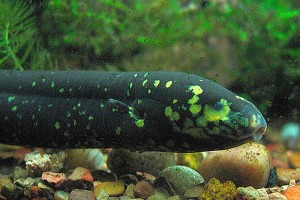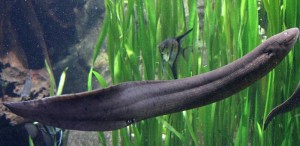The South American lungfish (Lepidosiren paradoxa) is the only species of lungfish found in South America.
It frequents swamps and slow moving waters in the Amazon, Rio Paraguay, and lower Paraná River basins, and is known to tropical fish keeping enthusiasts as the American Mud Fish, Amazonian Lungfish, or Scaly Salamanderfish. It is found in smaller numbers in Venezuela, Peru, Columbia, Brazil, French Guiana, Paraguay and Argentina, but the largest populations are predominately found in the Pio Parana and Rio Paraguay basins.
Juvenile South American lungfish are black spotted with gold, but as they grow into adulthood, their body colors fade into a gray or brown color.
Like all Dipnoi, South American lungfish have an elongated body. Their pectoral and anal fins are thin, ropey, and almost thread thread like in appearance. Their pelvic fins are set back and to the rear of the body, and are somewhat larger than their pectoral fins. Their dorsal fin begins about midway up the body to joins with the caudal fin underneath.
Although they posses gills as juveniles, they become non functional as they become adults. Adults posses fused teeth that become heavily mineralized and are used for crushing their prey before swallowing.
In their natural habitat, juvenile South American Lungfish primarily feed on snails and insect larvae. As they attain adulthood, they become more omnivorous and add algae, fish, and shrimp to their diets.
South American Lungfish have two “lungs” which are actually modified swim bladders that allow them to absorb oxygen and remove wastes. In waters with low oxygen content, they are able to breathe air through their swim bladders instead of their gills. If kept underwater, these lungfish will drown if they are unable to surface for a gulp of air.
During the dry seasons as their habitat gradually disappear, they burrow into the mud and produce a mucous lined chamber that is usually between 12″ and 20″ below the surface of the soil. A few holes are left in the chamber with access to the surface for air. During this aestivation, their metabolism and activity slows down almost to a complete stop and if necessary, they can remain this way for up to 4 years. As the rainy season begins again, they come out of their burrows and immediately begin mating.
South American Lungfish are large, messy fish, but relatively easy to keep in an aquarium environment. Because they are highly predatory, they
are best housed alone. They do require a good filtration system to keep their tank water clear and regular bi-weekly water changes of 20% to 30% are recommended, but they do not need need a lot of swimming area and can survive a wide range of water conditions.
Because they grow to over 4 feet long, South American Lungfish require a large tank of at least 60 gallons (initially) with very little water movement, a mud, sandy, or very fine gravel substrate, some aquatic plants and driftwood roots for them to hide among, and dim lighting.
Because of their soft skin, avoid placing any sharp rocks or coarse gravel in the tank and because of their large size as adults, a canister filter and outside heater is recommended to prevent damage to the equipment.
South American Lungfish are not very active and will spend most of their time on or near the bottom of the tank. They will surface occasionally to take a gulp of air, therefore the water surface should be unobstructed and their tank should never be tightly covered. Remember that these fish will drown without air.
The South American Lungfish has not been bred in captivity but in their natural environment, the adults will construct a tunnel type of hole “or nest” in the mud that they line with vegetal matter. They go into the “nest”, seal it off, lay their eggs, and guard them even hatching.
During the breeding season, the adults do not breathe through their lungs. Instead they breath with their gills and some thin branched appendages that temporarily develop in the males during the breeding season. These appendages are actually highly vascularized structures on the male’s pelvic fins that release additional oxygen into the nest. When the eggs hatch, the young lungfish larvae look like little tadpoles with four branched external gills, similar to those of newts. After 7 weeks, the young metamorphosize into their adult form, become air breathing, and exchange their external gills for gill openings.
South American Lungfish are easy to feed. The easiest way to feed them is to provide live, fresh dead, or fresh pieces of fish. They will also eat shrimp, crayfish, crabs, clams, insects, snails, worms, or anything that they can catch and fit into their mouths. Juveniles should be fed two times a day but adults only need to be fed two to three times a week. Occasional feedings of vegetable matter should also be given to round out their diet.
South American Lungfish are not a common item in tropical fish keeping shops but are usually available as a “special order” item at a moderate cost.
Minimum Tank Size: 60 gallons
Care Level: Difficult
Temperament: Semi-Aggressive
Aquarium Hardiness: Moderately Hardy
Water Conditions: 75.0 to 82.0° F, 2 – 20 dGH, pH 6.0-8.0
Size: 49.3″
Color Form: Brown, Gray
Diet: Carnivore
Compatibility: Single Species Only
Origin: South America
Family: Lepidosirenidae
Lifespan: 8-20 Years
Aquarist Experience Lever: Intermediate




